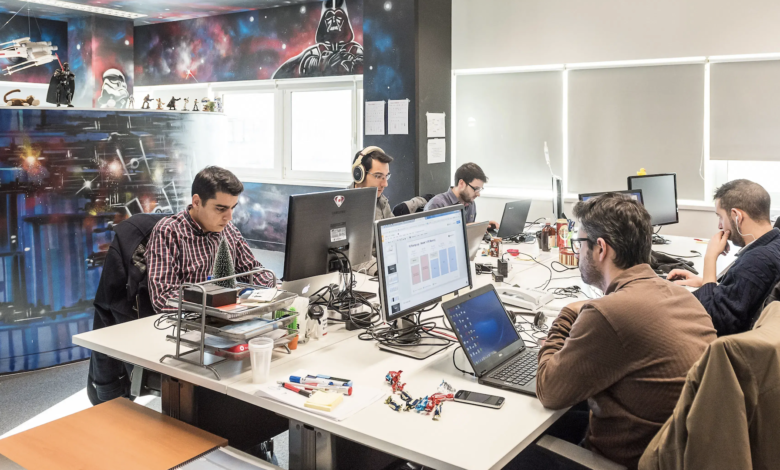
Citizen development has become an unexpected lifeline for UK businesses. The concept has enabled organisations of all sizes to meet increasing software development pressures whilst empowering employees to create simple app solutions without relying solely on their IT department.
This rising trend has become a vital solution for fast-paced organisations which need to alleviate the pressures of IT backlogs and mitigate the talent shortage among traditional developers. Every day, more businesses are empowering, with IT teams supporting, non-technical employees across diverse backgrounds to contribute actively to software development, fostering agility and innovation within organisations.
The positive business impact of citizen developers has also increased industry attention and interest in low code and its ability to dramatically increase developer productivity and innovation. Most recently, the use of AI-assisted software development in low-code has opened the door for another important resource to join the room – Generative AI.
Generative AI is highly anticipated to be the game changer when it comes to increasing the sophistication of citizen development, as well as accelerating software innovation for traditional developers. However, it is at risk of being misunderstood.
GenAI: debunking long-standing software development myths
When ChatGPT first came out, it triggered both industry excitement and apprehension. Some doubted its capabilities as well as its potential for biases or vulnerabilities through the training data provided. There was also fear that this technology might replace some human jobs – including the roles of software developers.
This fear and lack of trust in the unknown create some of the biggest barriers to innovation and hold the industry back from experimentation. There have been other low-code tools aimed at automating and speeding up the development process which has faced similar skepticism in the past. The technology was labeled as lacking scalability and robustness for enterprise-level systems, and was even seen as a threat to the developer’s role. All myths that stifle innovation.
In reality, most of the risks can be managed with clear business policies. For example, regarding security, any AI integration must occur within the confines of a secure platform. The chosen platform should have built-in security measures and standardised practices, to ensure that security measures are implemented and adhered to effectively.
Other common concerns around Generative AI are related to its transparency and accuracy which could create challenges in ensuring compliance with governance frameworks. The nature of Generative AI makes it difficult to anticipate the output, and this technology is evolving at such a fast pace that it is at risk of outpacing regulation.
As a result, some organisations are concerned that this use of AI will create more of a risk than an opportunity, as well as increase the risks of citizen development specifically. This makes it even more crucial for businesses to have the required safeguards in place, such as governance controls.
Evolving industry perceptions of GenAI
Today, there is a growing consensus that low code and automation significantly enhance developer efficiency and productivity, and Generative AI is playing an important role in advancing this. With the increasing popularity of Generative AI and AI-assisted software development, the trust in this technology to have a positive effect on software development and the developer’s day-to-day role has improved too.
Now, more developers are embracing low-code solutions, from simple code snippet generation to sophisticated platforms that streamline the entire software development lifecycle. This transition is not putting developers out of their jobs. Instead, it empowers them to achieve more in less time, mitigating challenges that once led to project delays.
Naturally, project delays and backlogs are a real pain point for IT but also the business more broadly. Each app left in the backlog is a missed opportunity to improve user experiences, increase process efficiency, or drive digital transformation. It often results in citizen developers attempting to build what they need without communicating with the IT team too. Mitigating these challenges is critical.
How GenAI enhances collaboration
However, as the use of Generative AI in software development gains momentum, the technology is being used more and more as a catalyst for projects, solving challenges that once hindered progress, and acting like a creative partner to the business. In software development, this opens new opportunities for collaboration between citizens and hardcore developers.
Although the disparity in their levels of technical expertise to project complexity is big, the adoption of Generative AI enables a more dynamic exchange of ideas, skills, and innovation. With Generative AI capabilities, citizen developers can provide their domain expertise, while developers can contribute their technical know-how to enhance full-cycle governance complexities. This synergy could produce effective digital solutions at a faster pace.
Beyond the impact that Generative AI has on developer productivity, it also holds immense benefits for IT departments and businesses. Whilst AI is accelerating innovation, organisations still face the challenge of managing technical debt that may be accumulated through AI-generated code, and ensuring long-term viability of applications, making a balanced approach essential. This means investing in technologies that provide visibility, control, and trust over AI-generated code.
In this landscape, AI harmoniously blends with human creativity, speeding up development cycles and freeing up developers to focus on more captivating work. Ultimately, the winning formula is a mixture of AI, low-code development, and human ingenuity, and ensuring a dynamic and efficient software development ecosystem.
More empowered citizen developers
With the huge potential to improve productivity and narrow the skills gap in the sector, Generative AI is becoming the new sidekick for software developers. Gartner predicts that by 2027, nearly 15% of new applications will emerge entirely through AI-driven processes. This prediction suggests that in the future citizen developers, with developer’s backup, will be able to create sophisticated applications simply through Generative AI prompts – improving efficiency.
With Generative AI finding its place in the room – not replacing but empowering citizen developers – businesses are better equipped to bridge the gap between demand and capabilities to develop enterprise-level software while capitalising on low-code and AI’s ability to automate manual repetitive processes, navigate change, and drive innovation.
Generative AI is not merely breaking down barriers but also redefining the collaborative landscape in software development, setting the stage for a future where AI and human creativity harmoniously coexist.


